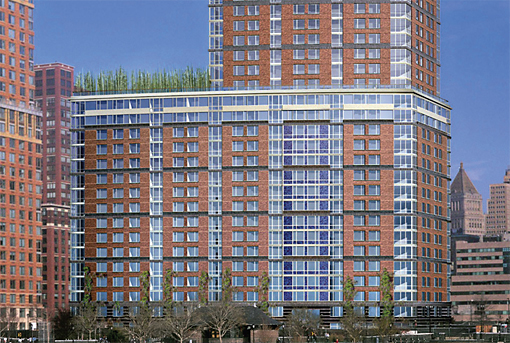| 제목 | [DAIKIN] CONDOMINIUMS - Solaire | 작성일 | 16-06-16 15:16 |
| 글쓴이 | 최고관리자 | 조회수 | 5,502 |
본문
The Solaire at 20 River Terrace, New York City, is the nation's first "green" residential building.
CASE STUDY
Condominiums
Name
The Solaire at 20 River Terrace
Location
New York, NY USA
Facility Size
27-stories, 293 luxury units
Issue
Consume 35% less energy than New York State Energy Code requirements
Solution
(2) 400-ton Daikin gas-fired absorption chillers
New York City's The Solaire Earns High LEED® Rating with Help from Daikin Chiller
The Solaire at 20 River Terrace, New York City, is a showcase for how new technologies and thoughtful design can work together to create an efficient, earth-friendly building that is comfortable to live in. Dedicated in September 2003, the nation's first "green" residential building in lower Manhattan attracts tenants for its indoor air quality, natural light and stunning views of the Hudson River.
Being energy efficient is essential to being green. The 27-story Solaire by developer Albanese Organization of Garden City, New York, is specifically designed to consume 35 percent less energy than New York State Energy Code requirements. This goal is driven by local Battery Park City Authority (BPCA) Residential Environmental Guidelines, as well as state tax credits. In 2000, New York State introduced the nation's first green building tax credit. These incentives have helped the developer in their attempt to achieve a gold rating from the Leadership in Energy and Environmental Design (LEED) program, sponsored by the U.S. Green Building Council (USGBC).
The building achieved significant advances in energy efficiency through the use of a gas-fired absorption chiller from Daikin. "This central heating and cooling system is the major contributor to the building's estimated 60 percent savings in energy costs, and uses an ozone-safe water-based refrigerant rather than CFC and HCFC-based refrigerants," said Martin Dettling, vice president, Albanese Organization, Inc.
The building's other energy-efficient innovations include photovoltaic cells that convert sunlight to electricity, compact fluorescent lighting fixtures with daylight dimming and occupancy sensor controls, and highly efficient condensate domestic hot water heaters.
Typically, a building's heating, ventilating and air conditioning (HVAC) system is one of its biggest energy users, and engineers who designed the Solaire looked specifically for a system with the lowest possible Btu usage. Two 400-ton Daikin gas-fired absorption chillers send chilled (or heated) water to fan coil units located in each apartment.
"Through manufacturers' test data, we found that a gas-fired absorption chiller is more energy efficient than a conventional electric centrifugal chiller," said Marvin Lewin, lead engineer with Cosentini Associates. "The motor and compressor of a centrifugal chiller require substantial amounts of electricity; a chiller is often a building's primary electric load. When you factor in the energy required to produce electricity, the loss of Btu's along the electric line, and actual use at the building, it was evident that gas was simply more efficient. Gas produces energy directly at the source; in this case, the high temperature generator of the chiller."
Absorption Chillers: Using Heat To Cool
Advances in absorption technology have made gas-fired absorption chillers efficient solutions for residential complexes, commercial buildings, government facilities, college campuses, hospitals and other facilities requiring large centralized heating and cooling systems. Today's high efficiency, double-effect, direct-fired absorption chillers/ heaters from Daikin are twice as efficient as the more traditional single effect designs, and they can be applied in most building designs throughout the country. The double-effect chiller uses two high temperature generators, which can boost the Coefficient of Performance (COP: the cooling output divided by the energy input). The COP of a single-effect absorption chiller is about 0.6, while a doubleeffect chiller has a COP of 1.0.
Among their many advantages, the chillers have minimal electrical power requirements; they primarily use heat energy with relatively small mechanical energy for pumping. That means a building's cooling requirements are shifted from an electric load to a thermal load, allowing facilities managers to bypass high demand charges and high cooling season rates. Many direct-fired absorption chillers don't even require boilers (steam-fired absorption chillers do, with only a slight loss in efficiency). That not only saves significant space in the mechanical room, it also reduces first cost, no need to buy a boiler. And because the absorption process does not require a large compressor or motor assembly to drive the process, the entire unit can be quieter and less prone to vibration. The chiller/heater combination, with the addition of a heat exchanger, can simultaneously generate hot and chilled water. The low nitric oxide type burner helps reduce emissions and meets stringent environmental codes.
LEED Points add up, Thanks to Absorption Technology
The efficiency of the absorption chiller contributed significantly to the LEED rating of the building. This point-based rating system awards a maximum of 69 points across six categories: Sustainable Sites; Water Efficiency; Energy and Atmosphere; Materials and Resources; Indoor Environmental Quality; and Innovation and Design Process. Most pertinent to HVAC design are two categories: Energy and Atmosphere, for a total of 17 points, and Indoor Environment Quality, which awards 15 points.
The intent of the Energy and Atmosphere category is to "achieve increasing levels of energy performance above the prerequisite standard and reduce environmental impacts associated with excessive energy use." By optimizing energy performance by 35 percent, and using a non-ozone depleting refrigerant, the chiller helped to add points to this category.
The system's thermal comfort and system controllability helped earn an additional point in the Indoor Environment Quality category. Microprocessor controls monitor the entire system, sensing and maintaining proper solution levels inside the chiller to prevent it from over or under-firing, and analyzing critical functions to aid in chiller maintenance.
Solaire Opens up a New View of Comfort
With its 293 luxury units averaging 1,000 square feet, the Solaire is fast becoming a desirable address in lower Manhattan. Residents enjoy amenities such as fresh air and filtered water to every apartment, extra thick sheetrock between units for added soundproofing and a rooftop garden complete with a rainwater storage system for irrigation. "The project was both rewarding and challenging," said Lewin. "It was a challenge to meet all the requirements, but ultimately satisfying to design a building that meets its goals and establishes a whole new set of criteria for future developments."

Unveiling the commemorative plaque at the opening of The Solaire, 2003.
| 이전글 | [DAIKIN] CONDOMINIUMS - One Crawford Place 2016-06-16 | ||
| 다음글 | [DAIKIN] ENTERTAINMENT - Cinemark Theaters 2016-06-16 | ||






